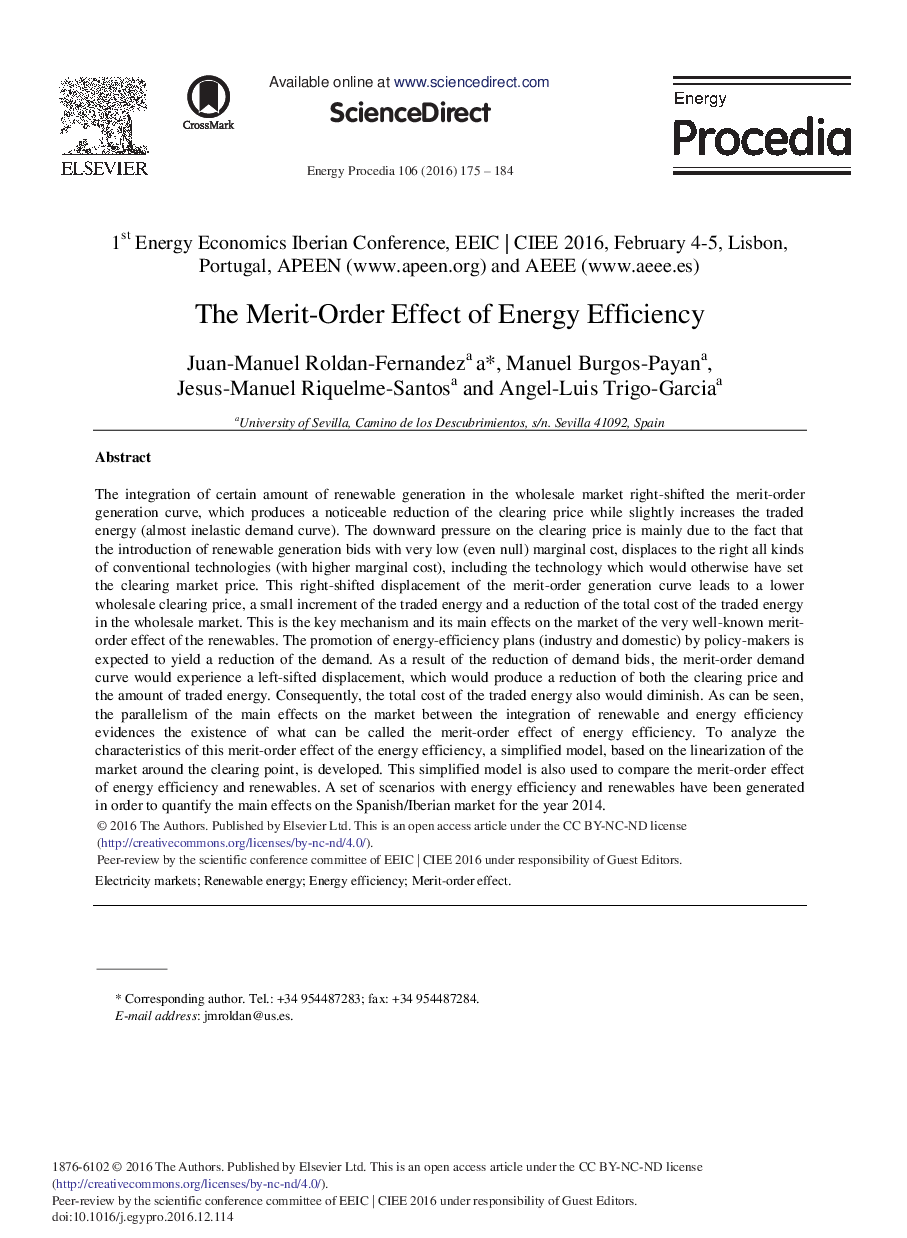| کد مقاله | کد نشریه | سال انتشار | مقاله انگلیسی | نسخه تمام متن |
|---|---|---|---|---|
| 5445973 | 1511130 | 2016 | 10 صفحه PDF | دانلود رایگان |
عنوان انگلیسی مقاله ISI
The Merit-Order Effect of Energy Efficiency
ترجمه فارسی عنوان
تأثیر برتری سفارش مصرف انرژی
دانلود مقاله + سفارش ترجمه
دانلود مقاله ISI انگلیسی
رایگان برای ایرانیان
کلمات کلیدی
بازار برق، انرژی تجدید پذیر، بهره وری انرژی، تأثیر شایستگی،
ترجمه چکیده
ادغام مقدار مشخصی از تولید تجدید پذیر در بازار عمده فروشی، منحنی نسبی تولید را به میزان قابل توجهی کاهش می دهد که باعث کاهش قابل ملاحظه قیمت پاکسازی می شود، در حالی که انرژی معامله شده تقریبا افزایش می یابد (تقریبا منحنی تقاضای تقریبا ناپایدار). فشار پایین در قیمت پاکسازی عمدتا به دلیل این واقعیت است که معرفی مقررات تولید تجدید پذیر با هزینه بسیار کم (حتی صفر) حاشیه ای، همه فن آوری های متعارف (با هزینه های بالاتری را)، از جمله فن آوری که در غیر این صورت قیمت بازار پاکسازی را تعیین خواهد کرد. این جابجایی راست جابجایی منحنی نسل پیشین، منجر به کاهش قیمت خرده فروشی عمده فروشی، افزایش کوچکی از انرژی معامله شده و کاهش کل هزینه انرژی معامله شده در بازار عمده فروشی می شود. این مکانیسم کلیدی و تاثیرات اصلی آن در بازار از اثر شناخته شده خیرخواهانه انرژی تجدید پذیر است. انتظار می رود که ارتقاء برنامه های صرفه جویی در مصرف انرژی (صنعت و داخلی) توسط سیاست گذاران موجب کاهش تقاضا شود. به عنوان یک نتیجه از کاهش پیشنهادات تقاضا، منحنی تقاضای سفارش شایستگی، یک جابه جایی چپ سوخته را تجربه خواهد کرد، که باعث کاهش هر دو قیمت پاکسازی و میزان انرژی معامله شده می شود. در نتیجه، هزینه کل انرژی معامله نیز کاهش می یابد. همانطور که مشاهده می شود، موازی بودن اثرات اصلی بر روی بازار بین ادغام تجدید پذیر و بهره وری انرژی، نشان دهنده وجود چه چیزی است که می توان به عنوان کارآیی شایستگی بهره وری انرژی نامید. برای تجزیه و تحلیل ویژگی های این اثر ارزشمندی از بهره وری انرژی، یک مدل ساده، بر اساس خطی کردن بازار در اطراف نقطه پاکسازی، توسعه یافته است. این مدل ساده نیز برای مقایسه اثر صحیح کارایی انرژی و بازسازی انرژی مورد استفاده قرار می گیرد. مجموعه ای از سناریوها با بهره وری انرژی و انرژی های تجدید شده تولید شده اند تا بتوانند اثرات اصلی را در بازار اسپانیایی / آیبیونی در سال 2014 تعیین کنند.
موضوعات مرتبط
مهندسی و علوم پایه
مهندسی انرژی
انرژی (عمومی)
چکیده انگلیسی
The integration of certain amount of renewable generation in the wholesale market right-shifted the merit-order generation curve, which produces a noticeable reduction of the clearing price while slightly increases the traded energy (almost inelastic demand curve). The downward pressure on the clearing price is mainly due to the fact that the introduction of renewable generation bids with very low (even null) marginal cost, displaces to the right all kinds of conventional technologies (with higher marginal cost), including the technology which would otherwise have set the clearing market price. This right-shifted displacement of the merit-order generation curve leads to a lower wholesale clearing price, a small increment of the traded energy and a reduction of the total cost of the traded energy in the wholesale market. This is the key mechanism and its main effects on the market of the very well-known merit-order effect of the renewables. The promotion of energy-efficiency plans (industry and domestic) by policy-makers is expected to yield a reduction of the demand. As a result of the reduction of demand bids, the merit-order demand curve would experience a left-sifted displacement, which would produce a reduction of both the clearing price and the amount of traded energy. Consequently, the total cost of the traded energy also would diminish. As can be seen, the parallelism of the main effects on the market between the integration of renewable and energy efficiency evidences the existence of what can be called the merit-order effect of energy efficiency. To analyze the characteristics of this merit-order effect of the energy efficiency, a simplified model, based on the linearization of the market around the clearing point, is developed. This simplified model is also used to compare the merit-order effect of energy efficiency and renewables. A set of scenarios with energy efficiency and renewables have been generated in order to quantify the main effects on the Spanish/Iberian market for the year 2014.
ناشر
Database: Elsevier - ScienceDirect (ساینس دایرکت)
Journal: Energy Procedia - Volume 106, December 2016, Pages 175-184
Journal: Energy Procedia - Volume 106, December 2016, Pages 175-184
نویسندگان
Juan-Manuel Roldan-Fernandez, Manuel Burgos-Payan, Jesus-Manuel Riquelme-Santos, Angel-Luis Trigo-Garcia,
